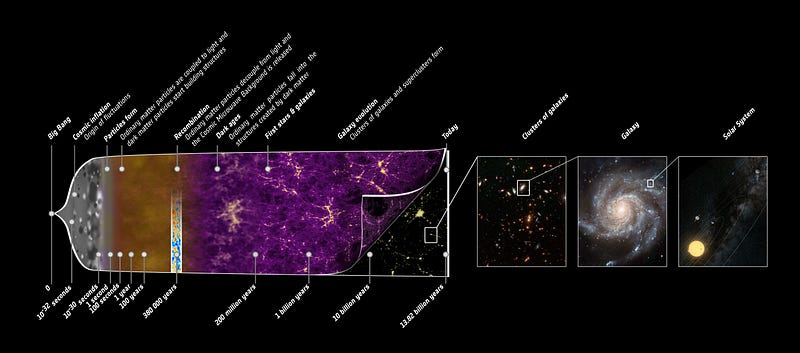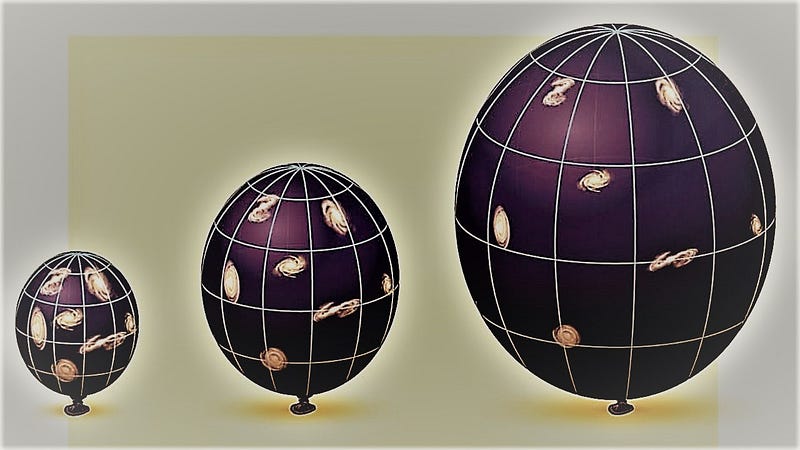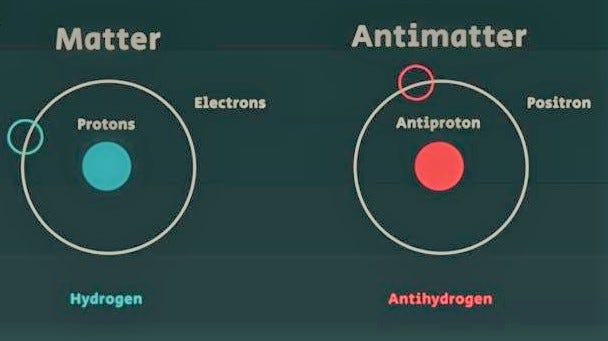The Cosmic Genesis: Understanding the Big Bang Theory
Written on
Chapter 1: The Expansive Universe
Our universe is incredibly vast, stretching approximately 93 billion light-years across. This means that light, the fastest entity known, takes a staggering 93 billion years to traverse from one end to the other. To put this into perspective, light travels at a speed of 300,000 kilometers per second; envision the distance it covers over such an immense timeframe.
We reside on Earth, a planet orbiting an average star within a universe brimming with countless celestial bodies. The Milky Way galaxy alone is estimated to harbor around 200 billion stars, with about 2 trillion galaxies present in the observable universe, each containing an average of 100 billion stars.
Given the enormity of the cosmos, it’s natural to ponder profound questions: Where did everything originate? How and when did it all come into being? Scientists have posited various theories to explore these phenomena, developing models to test against their observations. One prominent model is the Big Bang theory, which seeks to answer fundamental inquiries about the universe's inception.
Section 1.1: The Big Bang Model
According to the Big Bang theory, the universe emerged approximately 13.72 billion years ago, at a moment when neither time nor space existed. All matter and energy that we recognize today were once compressed into an infinitely small and dense point, famously termed the Big Bang Singularity by cosmologist Stephen Hawking.

Around 14 billion years ago, an unknown cause triggered the expansion of this singularity, birthing our universe. Scientists are still investigating the reason behind this occurrence, but we do know that it resulted in an explosive event—known as the Big Bang—marking the inception of all matter, energy, and even time itself.
While the term “Big Bang” might evoke images of a colossal explosion, it was actually an expansive event rather than an explosive one. Visualize blowing up a balloon; as it inflates, it creates space and time while dispersing energy throughout.

The energy generated from this initial expansion spawned all the matter in the universe, alongside another intriguing component: antimatter. Antimatter parallels matter but possesses opposite properties. For example, an electron (a matter particle) has a counterpart known as a positron, which shares the same mass but carries a positive charge.

One fascinating aspect of matter and antimatter is their annihilation upon contact, producing immense energy. The Big Bang's energy generated equal quantities of matter and antimatter, leading to a universe characterized by continual explosions.
A Brief Exploration of Matter and Antimatter
During the early universe, matter and antimatter collided, resulting in pure energy release, a phenomenon known as annihilation in physics. The radiation from these interactions still permeates our universe today. For instance, when you tune your television to an unused channel, the static noise you perceive contains 1% of the radiation from these historical collisions.

However, this raises a significant question: if all created matter was annihilated in these collisions, how did our current universe, rich in matter, come to be? This remains a perplexing mystery, and physicists have not yet uncovered a definitive answer. Solving this enigma could even lead to a Nobel Prize!
What we do know is that, for every billion collisions of matter and antimatter, only a single matter particle managed to survive. Everything we see today—from stars to galaxies—originates from this remnant.
After just one second post-Big Bang, the universe expanded to 100 million kilometers. As it grew, its temperature decreased, leading to the stabilization of matter particles. Quarks combined to form protons and neutrons, which subsequently united to create atomic nuclei. However, it wasn’t until approximately 380,000 years later that the first atoms came into existence, predominantly hydrogen, helium, and traces of lithium.
As gravity acted upon these gases, they began to coalesce into vast clouds, drawing in additional matter. Over hundreds of thousands of years, as the centers of these clouds intensified in temperature and pressure, hydrogen underwent fusion to create helium—a process known as nuclear fusion—resulting in the birth of stars. Scientists estimate that the universe's first stars emerged roughly 100 million years after the Big Bang.
Under gravitational influence, stars clustered together, forming galaxies and rendering the universe more recognizable. Yet, how can we be certain that this narrative accurately reflects past events? The evidence supporting this model is a story for another time.
Exploring the Origins of the Universe
The following video from National Geographic delves into the origins of the universe, providing insights into the Big Bang theory and its implications.